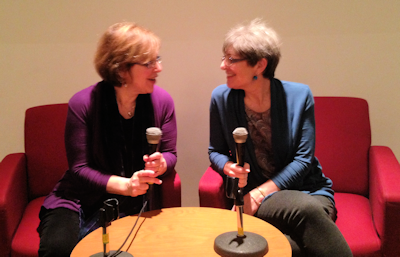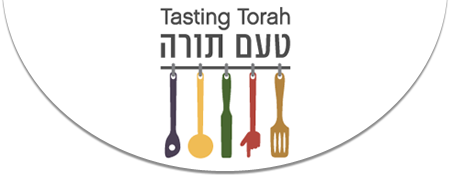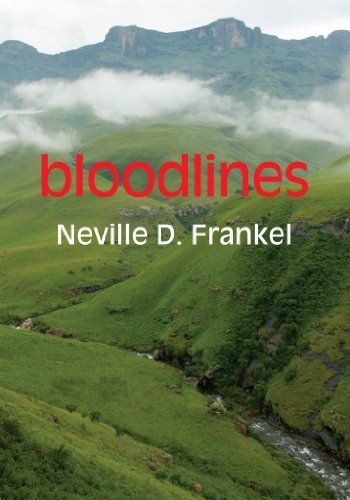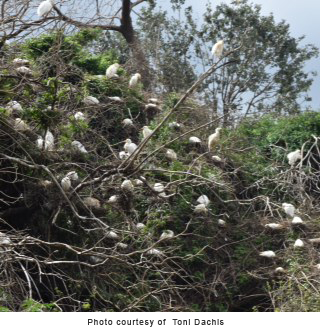 Doves nesting in the Arab Israeli city of Sakhnin? Are they also where they don’t belong or could these cattle egrets in winter plumage represent a piece of performance art-posing as doves at the entrance of an unusual building and museum promoting peace through dialogue and art?
Doves nesting in the Arab Israeli city of Sakhnin? Are they also where they don’t belong or could these cattle egrets in winter plumage represent a piece of performance art-posing as doves at the entrance of an unusual building and museum promoting peace through dialogue and art?
Although I am not an artist, I recently tagged along on the trip my sister planned along with Robyn Awend, Rabbi Alexander Davis and Anat Szendro for the Jewish Artists' Lab from the Minneapolis Sabes JCC. I love art, I love Israel, I love my Israeli cousins, and I trust my sister’s travel planning 100 percent based on vast experience.
Can a building be home to a revolution begun with art? I think so. The Arab Museum of Contemporary Art and Heritage (AMOCA) is housed in the Environmental Study Center, an ecological building designed by Egyptian architect, Abed Yassin in 2009. He designed this environmentally “green” building using the “language” of traditional Muslim architectural elements from bricks to windows. The architect himself led a tour of Jewish and Arab city planners, architects and historians from a School for Peace course (See www.sfpeace.org), an organization I just discovered while researching 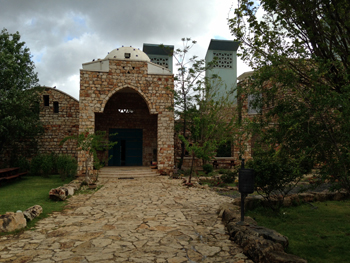 Yassin. Sakhnin is an Arab city, located in the lower Galillee, with a 3500 year history, currently home to a significant population of Arab Christians and the largest population of Sufi Muslims in Israel as well as the first Arab soocer team to win the Israel Cup.
Yassin. Sakhnin is an Arab city, located in the lower Galillee, with a 3500 year history, currently home to a significant population of Arab Christians and the largest population of Sufi Muslims in Israel as well as the first Arab soocer team to win the Israel Cup.
AMOCA* has a collection of 200 local and international contemporary artworks from Arab and Mediterranean countries. AMOCA was founded by a Rumanian-Israeli Jew and a University of Chicago graduate, Belu-Simion Fainaru, and his wife, Avital Bar-Shay. The Arab Museum of Contemporary Art might be a bit of a misnomer as some of the art comes from individuals with Islamic or Mediterranean roots who are not Arab, including Fainaru himself. If you are curious to know what a miraculous accomplishment it was to establish this museum and have artists agree to exhibit their work here, read the New York Times article Palestinian Museum Open, Minus Art. We were privileged to see the first exhibition entitled “HIWAR” meaning dialogue, which captures the essential purpose of the museum and building. This represents the second Mediterranean Biennial. I am attaching below Fainaru’s and Bar-Shay’s explanation of their intent as it is written so eloquently and expresses such revolutionary concepts that it is worth reading completely.

The hallway walls serve as galleries covered with art, but the walls of the classrooms, where tutoring occurs for the local children, are also intentionally filled with a continuation of this exhibit. The idea is accessibility. The multi-media exhibit offers a view of the breadth of opinions and issues in the Arab world. Most of the art is too provocative for the artists to show in their homelands. The patience and perseverance that the founders needed and the hard work of the mayor of the city of Sakhnin are remarkable. We were also impressed by the hutzpah of the local felafel restaurant’s owner to display provocative art lent by AMOCA on the walls of his restaurant and thank him for the outstanding felafel.
This was my kind of art – totally original and narrative. I could have stood in front of several pieces for hours, holding a discussion with other onlookers. One example is a video from Romania’s Ciprian Muresan, where a gray haired puppet emerges from a dumpster, protest sign in hand. As cars, bikes and pedestrians dart in and out of the video background, he says
“Join my protest against myself!
I’m protesting against myself because I’ve got no courage.
I’m protesting against myself because I’m afraid to protest.
I’m protesting against myself because I don’t know how to protest.
I’m protesting against myself because I don’t know how to join the protest.
I’m protesting against myself because I don’t believe protesting can change anything…”
I learned that what we saw was just a piece of a thirty minute video titled, Protesting against Myself (2011). The puppet also protests against himself because he talks in his sleep, because he has high cholesterol and for a number of other misfortunes. Then he adds finally.
“I protest against myself because I am a puppet.”
“I protest against myself because I’m actually not a puppet.”
“I protest against myself because I hide behind a puppet.”
“I protest against myself because I am an opportunistic puppet.”
In the full video, a human hand covers the puppet’s mouth and then a bald head is there inside the bin, presumably the puppeteer, who says “I protest against myself because I keep hiding in the bin whilst everything gets taken away from me.”
This had meaning on so many levels. I cannot speak for how it might connect to the failed Arab Spring. But I can speak to the universality of that message of shame and hopelessness. I think nothing more eloquently can capture what it feels like to be trapped in a state where your voice or collective voices mean nothing. I thought of how teenage Vera or Alla might have related to this. This artist was born in Communist Romania and was 12 when Communism fell. I also felt it on a personal level of the times when I did not speak out and should have.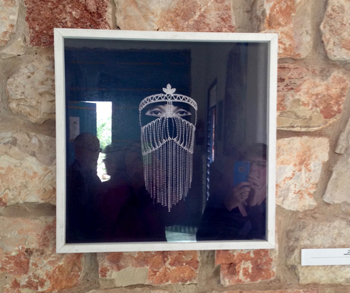
Fainaru's own art is visible as one looks into the courtyard. It is a traffic light flashing between its three colors with the words "Don't love" on the red light and "Love" on the green light. Is it our choice?
There were several beautiful portraits of a person dressed in traditional Arab female headcoverings. These were actually all photographs of the artist, Mehdi-Georges Lahlou (Morocco) and it compelled me to question the line between femininity and masculinity, noting how radically it is drawn in fundamentalist cultures, but how fluid it really is. Because of the light, one’s own reflection is also mirrored in the picture.
There was a lot of art by women. A piece which grabbed our attention was a video entitled “How your veil can help you in the case of an earthquake” (lessons 1-8) made by Anahita Razmi, an artist born in Hamburg of Iranian parents. This parody overexplains to women how your veil can be a functional object. It also refers to an earthquake that did occur in 2003 in Iran. The shock was how traditional this woman looked with her veil on, but as soon as she began using it as to flag down people in case of an earthquake as instructed in one lesson, the modern woman formerly “in disguise” emerges.
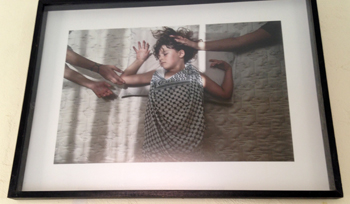 The final piece which caught my eye was a photograph by Abeer Atalla of a curly haired Arab girl sleeping peacefully with a kaffiyeh covering her like a blanket. A part of her is in light and a part in shadow. Two hands are reaching to her lovingly. One wonders what kind of life awaits her as she awakes and as she grows up. We assume and hope her stillness is sleep.
The final piece which caught my eye was a photograph by Abeer Atalla of a curly haired Arab girl sleeping peacefully with a kaffiyeh covering her like a blanket. A part of her is in light and a part in shadow. Two hands are reaching to her lovingly. One wonders what kind of life awaits her as she awakes and as she grows up. We assume and hope her stillness is sleep.
Worlds away, actually 87 miles away, in Modiin, we told my cousin, Noam and his partner, Gal, about our experience at Sakhnin. They immediately began to research whether it was open to Israeli Jews, was it an A,B or C city? This is an old designation based on the Helsinki Accords which specified which cities were governed by the Palestinian National Authority and were off limits to Jewish Israelis (A), which are divided between the PNA and the Israel Defense Forces (B), and which are fullt controlled by the IDF (C). So even within the small state, there are areas where Jews and Palestinians belong and areas where they don’t belong. Sakhnin is open to Jewish and Israeli visitors, 23 km east of Akko. Just ask any Israel about the Doha soccer stadium. Go there—even if you think you don’t belong, and stop for felafel at the local restaurant. By the way, Belu asked me to deliver a gift to a friend who lives in Minneapolis, and based on my blog from last week, you know I happily did it.
Note: Thanks to Toni Dachis for the photograph of the birds and to Dr. Barbara Krupp for her bird identification skills.
More information from www.mediterraneanbiennial.com Mediterranean Biennial
"Israel’s socio-political reality causes her to be detached from neighboring countries, while linking her to distant centers in Europe and the US. Adoption of the concepts of the powerful Western art centers prevented the possibility of noticing any artwork in our area in neighboring countries with a similar climate and comparable cultural characteristics. In this context, the Mediterranean Biennale of contemporary art was initiated by Belu-Simion Fainaru and Avital Bar-Shay. The first Mediterranean Biennale was held in 2010 in the city of Haifa and the second Mediterranean Biennale will be held in the city of Sakhnin in the Galilee in north of Israel.
The Second Mediterranean Biennale, in Sakhnin, is an attempt to create a cultural outlook in a Mediterranean context via regional cooperation by exhibiting works of art that express and enhance this theme. The Second Mediterranean Biennale will offer an alternative platform laying emphasis on the local processes occurring in the area and their cultural influences. The Biennale will be an international art event also involving Israeli artists, both Jewish and Arab, including international artists. The place of the woman as a creative individual will also be given special emphasis.
This is the first time that an international biennale of contemporary art will be held in an Arab city in Israel. Holding such an international art event of this kind will engender a place for coexistence and dialogue by means of artistic endeavor. Art in this case acquires an important social standing by creating conditions for rapprochement, learning to recognize and showing respect for the difference of the other. Holding the event in the city of Sakhnin will further the possibility of getting to know Arab culture better by observing life in the city and making direct contact with its inhabitants. (LA’s underlining)
As a direct extension and elaboration of educational and cultural activities that the Mediterranean Biennale set for itself, we will establish a center [which] includes a contemporary art gallery, an 'artist residence' program in which artist from neighbor countries will be hosted for [a] short period of time and will create art in the place, and a place of studying, researching and documenting the local visual Mediterranean culture. The Mediterranean Biennale provides opportunities for meeting and exchanging opinions, and forming bonds leading to future activities. The center is a sort of laboratory where the various ideas and suggestions expressed can be examined and put into practice. The purpose of The Mediterranean Biennale is to create a new contact system, through which artists from the nearby areas can cooperate, initiate activities and exchange views, unencumbered by the fixed patterns of the established systems."
